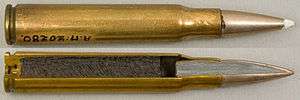8×63mm patron m/32
The 8×63mm patron m/32 was a bottlenecked centrefire cartridge with a slightly (0.25 mm (0.0098 in)) rebated rim for Swedish heavy and medium machine guns. It was used from 1932 to the finalization of the re-chambering process of these machine guns to 7.62×51mm NATO in 1975.
| 8×63mm | ||||||||||||||||||||
|---|---|---|---|---|---|---|---|---|---|---|---|---|---|---|---|---|---|---|---|---|
 Two 8×63mm patron m/32 military cartridges | ||||||||||||||||||||
| Type | Rifle | |||||||||||||||||||
| Place of origin | Sweden | |||||||||||||||||||
| Service history | ||||||||||||||||||||
| In service | 1932–1975 | |||||||||||||||||||
| Used by | Sweden | |||||||||||||||||||
| Wars | UN intervention in Kongo 1960-1964 | |||||||||||||||||||
| Production history | ||||||||||||||||||||
| Designer | Royal Swedish Army Materiel Administration (KAF), AB Bofors | |||||||||||||||||||
| Designed | late 1920s, early 1930s | |||||||||||||||||||
| Manufacturer | AB Bofors | |||||||||||||||||||
| Specifications | ||||||||||||||||||||
| Case type | Rimless, bottleneck | |||||||||||||||||||
| Bullet diameter | 8.20 mm (0.323 in) | |||||||||||||||||||
| Neck diameter | 9.10 mm (0.358 in) | |||||||||||||||||||
| Shoulder diameter | 11.51 mm (0.453 in) | |||||||||||||||||||
| Base diameter | 12.43 mm (0.489 in) | |||||||||||||||||||
| Rim diameter | 12.18 mm (0.480 in) | |||||||||||||||||||
| Rim thickness | 1.42 mm (0.056 in) | |||||||||||||||||||
| Case length | 62.81 mm (2.473 in) | |||||||||||||||||||
| Overall length | 84.62 mm (3.331 in) | |||||||||||||||||||
| Primer type | Large rifle | |||||||||||||||||||
| Ballistic performance | ||||||||||||||||||||
| ||||||||||||||||||||
| Test barrel length: 609 mm (24 in) Source(s): [1] | ||||||||||||||||||||
In the late 1920s, the standard service cartridge in Swedish use was the 6.5×55mm Swedish skarp patron m/94 projektil m/94 (live cartridge m/94 projectile m/94) service ammunition loaded with a 10.1 grams (156 gr) long round-nosed m/94 (B-projectile) bullet which was not considered effective enough for anti-aircraft and indirect fire so the Royal Swedish Army Materiel Administration tasked AB Bofors to manufacture a larger rifle cartridge to meet these needs.

Right; 7.92×57mm Mauser cartridge
with 14.2 g (219.1 gr) m/32 and 11.55 g (178.2 gr) S.m.E. 8 mm S bore bullets
The patron m/32 round had the same overall length as the .30-06 Springfield cartridge, which allowed it to fit in the standard Browning receiver, but used a larger diameter case and like the 6.5×55mm had an uncommon 12.2 mm (0.48 in) diameter bolt face. Compared to the 1928 pattern .30-06 Springfield M1 Ball the 8×63mm patron m/32 was loaded with 8 mm S bore 14.2 g (219.1 gr) bullets and had more muzzle energy.[2]
The patron m/32's boat-tailed spitzer bullets had an effective range of approximately 3,600 m (3,937 yd) on which the impact energy was 196 J (145 ft⋅lbf), and a maximum range of approximately 5,500 m (6,015 yd) when fired from a kulspruta m/36.[3] Available with armour piercing bullets, patron m/32 was used in the UN-forces' KP-bil during the Congo-crisis against the separatists' armoured cars.
The 8×63mm patron m/32 cartridge was used in the following machine guns:[4]
- M1919 Browning machine gun Ksp m/22
- Kulspruta m/14-29
- Kulspruta m/36
- Ksp m/39 machine gun
- Ksp m/42 machine gun
The 8×63mm patron m/32 was also used in the gevär m/40 bolt-action rifle. These were Karabiner 98k's re-chambered in Sweden for the patron m/32 and issued to the machine gun troops so their rifles would fire the same round as their machine guns. There are statements the gevär m/40 originally was intended as a stop-gap anti-tank rifle, but this has yet to be confirmed.
References
External links
| Wikimedia Commons has media related to 8×63mm patron m/32. |
- 8x63 M32 Bofors
- HISTORIC MACHINE GUN CARTRIDGES by Anthony G Williams
- 8x63 Swedish / 8x63 Bofors (in Russian)
- 8x63 Swedish Bofors / 8 mm Bofors / 8x63 Swedish For MG Mod.1932 / 8mm SK PTR M-32 / 8mm Sueco / 8x63 / SAA 4540 / XCR 08 063 BGC 010 (In Spanish)
- The Swedish military ammunition site
- Ammunitionsregister för armén, 1960